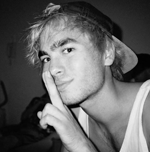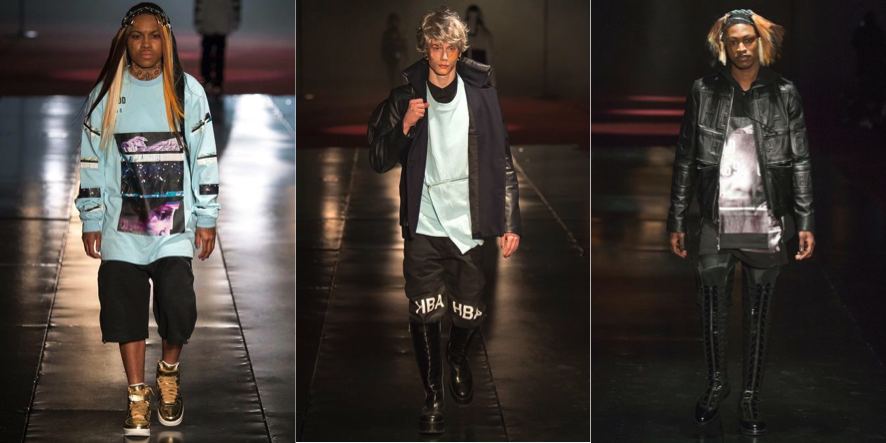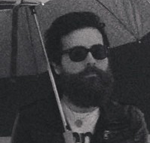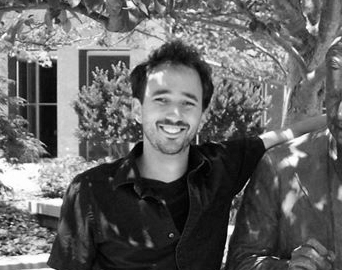
Let’s take a look at some recent moments in pop culture…. Beyoncé has continued to embody and exude perfection, Macklemore performed “Same Love” at the Grammys after winning Best Rap Album, Miley has continued to be Miley, Jay Z won a golden sippy-cup for Blue Ivy, Laverne Cox was the perfect “possibility model” in response to an invasive Katie Couric, the Olympics have commenced in a homophobic Russia, and, well, the list could go on. All of these moments are situated very firmly within mainstream America, and all of these moments are evidence of a recent and overt interest by mainstream America in both black and LGBTQ culture. Although the fashion world might not exist entirely within the American mainstream, I’d like to add another event to this list: last Sunday, Hood By Air (The website is no longer available) began NYFW with a momentous show, climaxing in a finale of voguers dancing fiercely across the runway. The show was paired with a short film by Nick Knight’s SHOWstudio called “fuccboi” (the name of which – a derogatory term for trend followers – can only fully be explained through experience). I’m no expert on either fashion or the ball scene, but the show struck me as a cultural moment that deserves both recognition and celebration.
Video is no longer available.
Hood By Air was created in 2006 by Shayne Oliver and Raul Lopez, emerging from a scene centered around DJ Venus X and producer Physical Therapy’s itinerant club night GHE20GOTH1K [link no longer active]. I was introduced to the label – long with much of its fan base – following HBA’s fall 2013 debut at NYFW last year. In particular, I was attracted by rapper A$AP Rocky closing the show. I quickly began to notice the characteristically internet-y graphics, abundant logos, and inimitable style on the backs of rappers such as Kanye, Kendrick Lamar, and Drake. Knowing HBA pretty singularly through such celebrity cameos, I grouped the brand with other “luxury streetwear” designers that have been gaining influence in mainstream press (such as Shaun Samson or Nazir Mazhar). I thought of the brand as quintessentially hip hop or urban, and I found its exuberantly masculine sexuality to be both provocative and seductive. Knowing nothing about Shayne Oliver (the force behind the label), I associated the brand with A$AP Mob, as part of the mood-of-the moment in which mainstream white America has been entranced by the “edginess” of black America. Situating the brand within the context of such widespread and unapologetic cultural appropriation didn’t curb my lust for the brand’s “classics line” of $180 tee-shirts, however, and weirdly, I disassociated my personal desire for the brand’s swagged-out aesthetic with blackness almost entirely, but instead with a more individual motivation that stems from an ongoing analysis of my own queer identity and presentation. Although I didn’t yet know the words for the feeling, I found myself drawn to the trend of athletic wear and streetwear without consciously associating it with black America, but simply with straight masculinity.
What I didn’t recognize was the ways in which I was playing into a particularly sexualized representation of blackness that has roots as far back as slavery. Othered politically, the male slave population was institutionally feminized in their disenfranchisement, called by Robert E. Park (ghost writer to Booker T. Washington) the “lady among the races”[i]. bell hooks has more contemporaneously discussed the ways in which hetero black men have internalized their white, patriarchal culture’s sexist/ racist ideology, acting as though the “primary ‘evil’ of racism has been the refusal of the dominant culture to allow them full access to patriarchal power, so that in sexist terms they are compelled to inhabit a sphere of powerlessness, deemed ‘feminine,’ hence they have perceived themselves as emasculated”[ii]. This feminized representation of black male identity has been internalized by many, leading to a reactionary performativity within black male culture of hyper-masculinity. This has been lambasted most popularly in the critique of rap and hip hop as being both misogynistic and homophobic. Although these critiques are faulty in their singularizing definitions of both blackness and the genres, in the words [This link is no longer available] of Ice Cube, “’true niggers ain’t gay’”.[iii] For the ideologists of black masculinism, the presence of gay, black men runs contrary to their understanding of racial authenticity, exposing the depths of their own racial and sexual alienation, but resulting ultimately in the further alienation of gay individuals, demanding a choice be made between their incompatible gay and black identities.[iv]
“I remember my dad saying ‘You have three strikes against you in this world. Every black man has two: they’re black and they’re male. But, you’re black and you’re male and you’re gay. You’re gonna have a hard fucking time.’”[v]
This voiceover begins Jennie Livingston’s immortalizing documentary Paris is Burning. Although exposing me to the ball scene and the art of voguing (albeit superficially), I was captivated most by the film’s segment on “realness”. In the film, Pepper LaBeija defines realness as the ability “to be able to blend”: “the realer you look means you look like a real woman. Or you look like a real man. A straight man.”[vi] This conception of realness, although defined heteronormatively, undeniably resonated with me (and I imagine, with most anyone in the queer community). You certainly can’t hide the color of your skin, but you sure as hell can hide your gayness. This concept led me to read about a subculture within the queer black community identifying as “homo thugz”. Part of the subscription to this style is merely practical, for, as stated by one clubgoer at a gay club’s hip-hop night, “’straight-up homies, niggaz, and thugz can do what they want. You can walk through projects and be gay. But you can’t walk through projects and be a faggot.”[vii] Through adopting a machismo style and lifestyle, these gay men distance themselves from associations with words like gay, queer, and faggot, instead prioritizing their identification with black culture. Ironically, Kendall Thomas notes how such self-conscious stylization of the body creates an “uncanny [correspondence] with that apotheosized symbol of the feminine, the diva”.[viii] Levingston’s film shows categories at balls in which children compete in categories based upon various manifestations of realness (think military men and executives), showing how such stylization was recognized and celebrated as a type of performance.

I went online last week and realized NYFW was mid-session and immediately went to look at Hood By Air’s fall 2014 collection. I hadn’t seen much of the brand beyond its series of highly-saleable tees and the endless shots of rappers wearing the blown-out logo, so to be met with a video of five dancers voguing on the runway was a bit of a surprise. My first thought was Rick Owen’s s/s14 show in Paris that featured an American step team as models, which, although absolutely brilliant, struck me as a little exploitive. Fashion certainly isn’t oblivious to the recent fondness for appropriation, but something about this performance felt more honest; it felt like more than just a fashion statement. It hardly took a google search to realize that Shayne Oliver is gay, and upon looking at the collection more thoroughly, that the brand extends far beyond a fetishistic exaggeration of masculinity. According to Shayne, the brand began in his teens with a series of shirts that said “HOOD” across the chest:
“They were something we’d rock around town, almost to be obnoxious. We’d be running around wearing heels with parts down the middle of our hair, but wearing these t-shirts that said ‘Hood,’ just to mix it up. I’d sometimes get into altercations with people over [the shirts], but at least I knew there was power in something I made.”[ix]
From its beginnings, HBA has fused hip-hop and punk aesthetics, creating a brand that’s at once satirical and empowering. Once I actually looked through HBA’s collections, I realized that the brand extends far beyond graphic tees and sweatshirts (and anything that might resemble a conservative’s definition of menswear). With Kevin Amato doing the casting (a photographer known for his raw portraits of often thuggish-looking young men), HBA sends unconventional models down the runway who seem “more likely to beat [Shayne] up, than to let him dress them” (Vogue’s description, not mine).[x] But, nonetheless, the clothes these men are wearing include boxer-length denim zip-offs, grommeted suede bombers, fur-lined crop tops, and, of course, chest-length weave head pieces. To put it in Shayne’s words: “I wanted to … put the glamour on them”.[xi]
Although HBA has always pulled from gay aesthetics, last fall (HBA’s first season at NYFW) the brand rode firmly into the lime light through its association with A$AP Rocky (he raps, “Hood By Air, man I started that”). In a society where fashion is primarily consumed online, it’s not unusual for people to only see what creates headlines. Last year it was A$AP ending the show, since then it’s been on backs of rap stars, from paparazzi shots to magazine covers. But this time it was voguers. Not only that, it was voguers and fuccbois. And the thing is, it was actually a daring move. A quick scan across any streetwear blogs covering the show will show that a lot of people were more than just confused:
Or to perfectly summarize my point:
But what I really love about the situation is that HBA’s androgynous aesthetic has been there all along. I mean, it wasn’t until HBA came along that rappers wearing skirts [site no longer live] felt utterly common place. The thing is that most people had never seen the clothes on anyone but these hyper-masculine personas, and the clothes (whether a skirt or a bomber) only became part of that persona. Shayne isn’t interested in toying with gender norms or androgyny per se, he’s interested in creating works that “exude power”.[xii] And Shayne’s sense of power draws from ballroom glamour, banjee boys, rappers, and punk kids alike. His sense of power comes from fuccbois who “shred the status quo with aggression and lush energies”. And the result is undeniably powerful.
What I find so exciting about HBA is that last week’s show didn’t allow Shayne’s roots to remain implicit in the clothes, he chose to place the power of the ballroom front and center. In a culture that survives off the systematic exploitation of marginalized communities, the ability for these communities to find a voice within the mainstream is rare indeed. But one only has to look around to realize that times are quickly changing. We live in a post-“Same Love” world, and although Macklemore might still be unrightfully winning Grammys, the backlash against a white, hetero man rapping on behalf of the LGBTQ community is proof enough. Mark my words, it won’t be long until the likes of Azealia Banks, Angel Haze, Mykki Blanco, Le1f, and Zebra Katz dominate the radio waves (all openly gay and openly talented). With many of the voguers in HBA being high-school friends of Shayne’s (he vogues in his spare time as well), the performance couldn’t be further from mere spectacle. On the contrary, it’s a glimpse from the mainstream of an insurrection that is only beginning.
[i] Gibson, Donald. “Chapter One of Booker T Washington’s Up From Slavery and the Feminization of the African American Male.” Representing Black Men. 1st ed. London: Routledge, 1995. 95. Print.
[ii] http://pica.org/wp-content/uploads/2013/08/hooks-Is-Paris-Burning_.pdf
[iii] Trebay, Guy. “Homo thugz blow up the spot.” Village Voice[New York] 08 Feb 2000, 44-49. Print.
[iv] Thomas, Kendall. “‘Ain’t Nothing Like the Real Thing’: Black Masculinity, Gay Sexuality, and the Jargon of Authenticity.” Trans. Array Representing Black Men. . 1st ed. London: Routledge, 1995. 61 & 66. Print.
[v] Livingston, Jennie, dir. Paris is Burning. Off White Productions, 1990. Film. 18 Feb 2014.
[vi] Ibid.
[vii] Trebay, 46
[viii] Ibid.
[ix] Chapman, Alex. “SHAYNE OLIVER’S HOOD.”Interview Magazine. 03 Mar 2012: Web. 18 Feb. 2014. <http://www.interviewmagazine.com/fashion/hood-by-air-shayne-oliver/
[x] Brown, Jacob. “Hood by Air Spring 2014: The Future Androgynous.” Vogue. 08 Sep 2013: n. page. Web. 18 Feb. 2014. <http://www.vogue.com/vogue-daily/article/the-future-androgynous-hood-by-air-spring-2014/
[xi] Brown, Jacob. “Post-Apocalyptic Warriors and Voguing on the Runway at Hood by Air Men’s Fall 2014.”Vogue. 09 Feb 2014: Web. 18 Feb. 2014. <http://www.vogue.com/vogue-daily/article/post-apocalyptic-warriors-and-voguing-on-the-runway-at-hood-by-air-mens-fall-2014/
[xii] Bernard, Katherine. “Word on the Street: Why Hood by Air Is Getting Front-Row Attention.” Vogue. 11 Jun 2013: Web. 18 Feb. 2014. <http://www.vogue.com/vogue-daily/article/word-on-the-street-why-hood-by-air-is-getting-front-row-attention/




